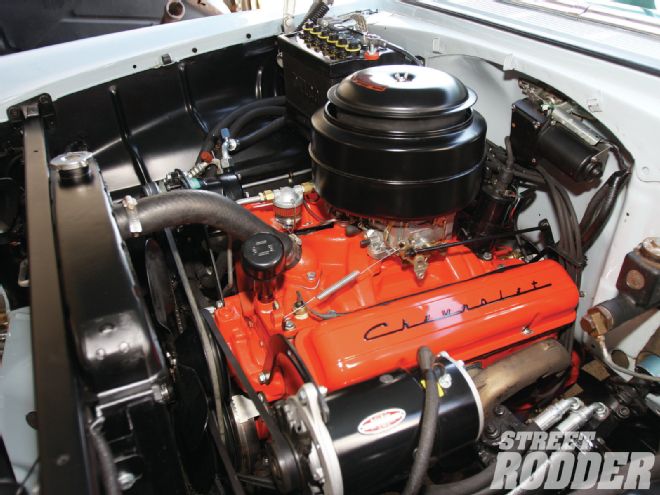
As teenagers we wanted people to think we were older. It never worked. Our fake ID (a driver's license with the DOB changed using dad's typewriter) wasn't convincing enough to fool our way into an adult movie or trick the market clerk out of a six-pack of beer. Now we wish people thought we were younger. The waitress who might've flirted with us at one time now smiles with granddaughterly warmth as she hands over the geezer discount menu.
When it comes to car projects, the trend goes both ways. Some street rodders choose to dress up their early cars with modern-looking components, from plus-sized wheels to high-tech engines and in-dash LED screens. For others, maintaining a traditional appearance is important, even if the appearance is deceiving.
The 1955 Chevy that recently showed up at Hollywood Hot Rods (HHR) had been carefully and accurately restored—just the way the owner liked it, almost. The owner wanted to go faster than the stock six-cylinder and Powerglide were capable of going. He also wanted a standard transmission and disc brakes.
The solution to the performance problem was a Chevrolet Performance ZZ383/425 engine with Fast Burn cylinder heads, a Tremec TKO five-speed, and Wilwood discs at the front wheels. Those conversions satisfied the owner's go-fast needs, but sacrificed the car's stock identity.
The solution to the appearance problem, and the challenge for HHR, was to create a fake ID for the new ZZ383 to make it look like a restored early V-8. Troy Ladd and the other fabricators at HHR studied photos of stock 1955-57 Chevy 265 engines to create a convincing camouflage. The first modification was to cut the motor mounts from the side of the 383 block and add front mounts with donut bushings. The finished result is not intended to be a precise 265 replication, but to make it look as authentic as practically possible—and to make the appearance of the engine compartment consistent with the overall look of the 1955.
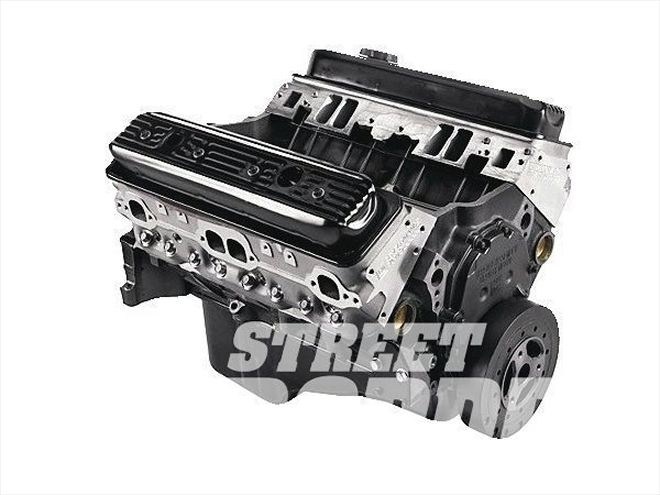 1. Compare the upper photo with the lower photo of a ZZ383/425. Chevrolet Performance’s 425-horse version of the 383ci crate small-block has a lot to offer, except nostalgic looks. But that can be fixed. Photo courtesy of Chevrolet Performance.
1. Compare the upper photo with the lower photo of a ZZ383/425. Chevrolet Performance’s 425-horse version of the 383ci crate small-block has a lot to offer, except nostalgic looks. But that can be fixed. Photo courtesy of Chevrolet Performance.
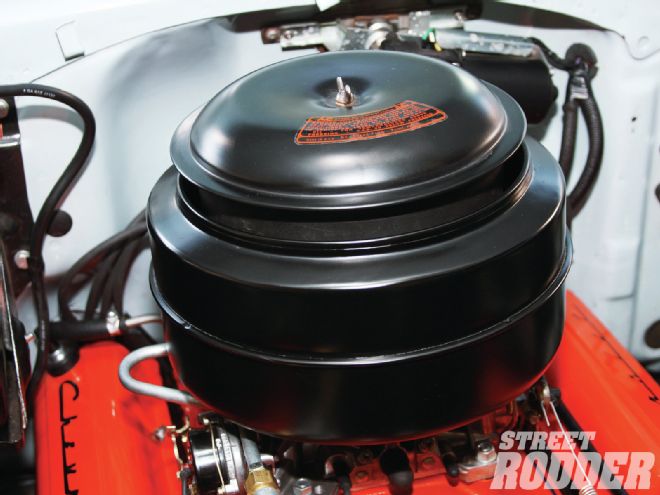 2. The vintage air cleaner is the most prominent element. This is an original A/C oil bath air cleaner—complete with decal—that was gutted and now houses a K&N washable filter. Vents, out-of-sight in the bottom of the assembly, draw in more air for plenty of flow.
2. The vintage air cleaner is the most prominent element. This is an original A/C oil bath air cleaner—complete with decal—that was gutted and now houses a K&N washable filter. Vents, out-of-sight in the bottom of the assembly, draw in more air for plenty of flow.
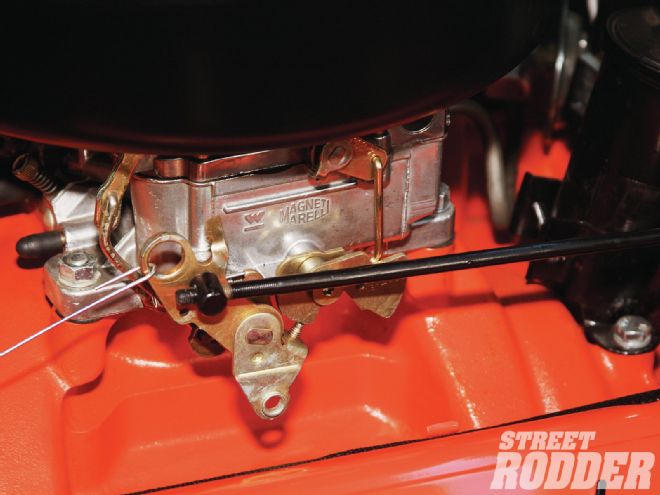 3. Identifying badging was eliminated from the Edelbrock carburetor (edelbrock.com). In this form it resembles an original Carter. Edelbrock carbs evolved from Carter designs and are manufactured by Magneti Marelli Powertrain USA, which also owns Weber (note the Weber and Magneti Marelli logos stamped on the side).
3. Identifying badging was eliminated from the Edelbrock carburetor (edelbrock.com). In this form it resembles an original Carter. Edelbrock carbs evolved from Carter designs and are manufactured by Magneti Marelli Powertrain USA, which also owns Weber (note the Weber and Magneti Marelli logos stamped on the side).
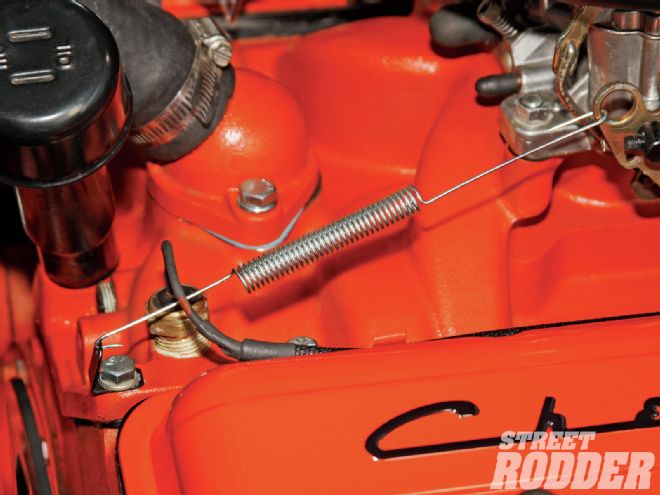 4. Chevy chose the throttle return spring location for convenience, not appearance; however, appearance is why it is located here, in the period-correct location on this faux 265.
4. Chevy chose the throttle return spring location for convenience, not appearance; however, appearance is why it is located here, in the period-correct location on this faux 265.
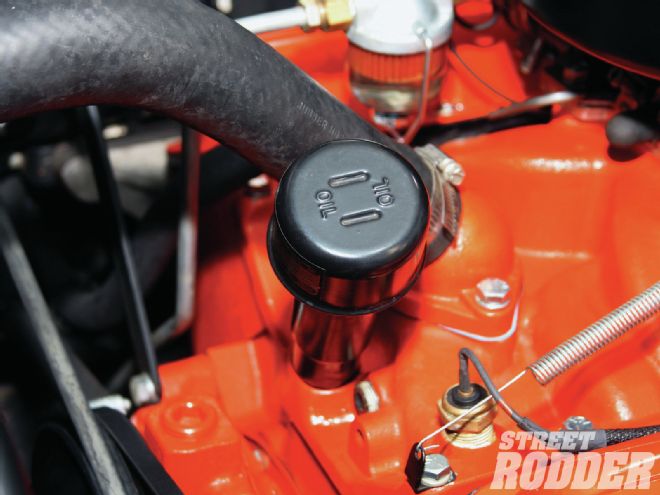 5. A front oil fill tube is an important identifying component of an early manifold. To relocate the tube, the front of the Chevrolet Performance intake manifold had to be ground. A small mound was shaped from aluminum and welded to the manifold where the functional fill tube was to go. The fill tube was then pressed in place and welded. Other stampings were ground, labels removed, and contours were shaped to give the intake the appearance of a rougher casting.
5. A front oil fill tube is an important identifying component of an early manifold. To relocate the tube, the front of the Chevrolet Performance intake manifold had to be ground. A small mound was shaped from aluminum and welded to the manifold where the functional fill tube was to go. The fill tube was then pressed in place and welded. Other stampings were ground, labels removed, and contours were shaped to give the intake the appearance of a rougher casting.
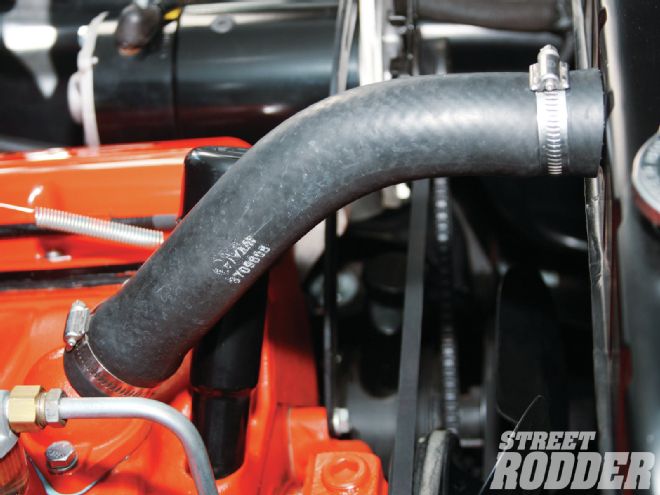 6. The upper radiator hose is a GM replacement part with the original white markings, available from aftermarket restoration sources on the Internet.
6. The upper radiator hose is a GM replacement part with the original white markings, available from aftermarket restoration sources on the Internet.
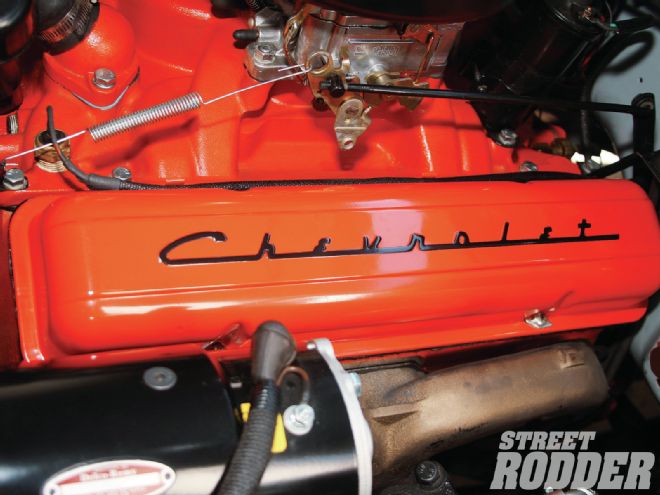 7. A pair of original 1955 Chevy valve covers replaces the modern ZZ383 valve covers. Speedway Motors (speedwaymotors.com, PN 91017157) is one source for the adaptors needed to use early staggered bolt valve covers with modern center bolt heads.
7. A pair of original 1955 Chevy valve covers replaces the modern ZZ383 valve covers. Speedway Motors (speedwaymotors.com, PN 91017157) is one source for the adaptors needed to use early staggered bolt valve covers with modern center bolt heads.
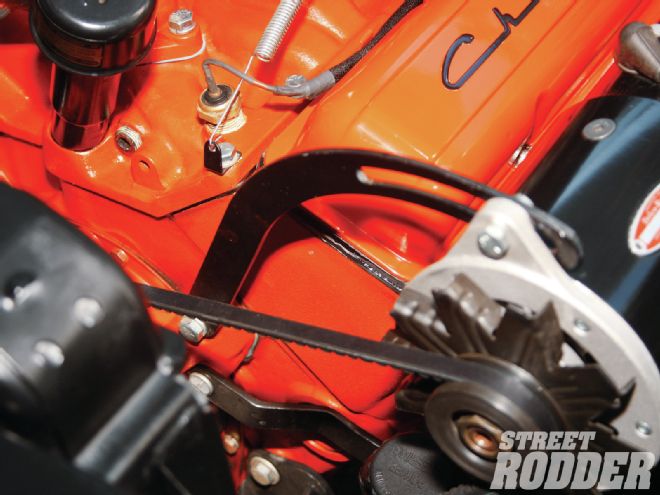 8. The Fast Burn aluminum heads were ground around the seams and corners. HHR machined the lettering off the smooth flat front surfaces, filled the accessory holes, and reshaped corners and edges to look more like a rougher casting. A scaler was used to add the texture of cast iron. Chevy engine orange paint finishes the illusion. You could go even further with more machining to replicate the raised stampings found on the front of 265 heads.
8. The Fast Burn aluminum heads were ground around the seams and corners. HHR machined the lettering off the smooth flat front surfaces, filled the accessory holes, and reshaped corners and edges to look more like a rougher casting. A scaler was used to add the texture of cast iron. Chevy engine orange paint finishes the illusion. You could go even further with more machining to replicate the raised stampings found on the front of 265 heads.
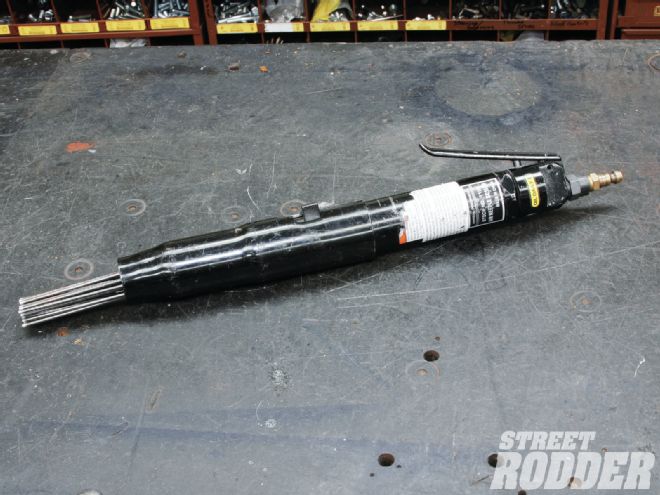 9. A pneumatic needle scaler, like this one from Harbor Freight (harborfreight.com), is typically used to remove paint or rust from metal prior to repainting or welding.
9. A pneumatic needle scaler, like this one from Harbor Freight (harborfreight.com), is typically used to remove paint or rust from metal prior to repainting or welding.
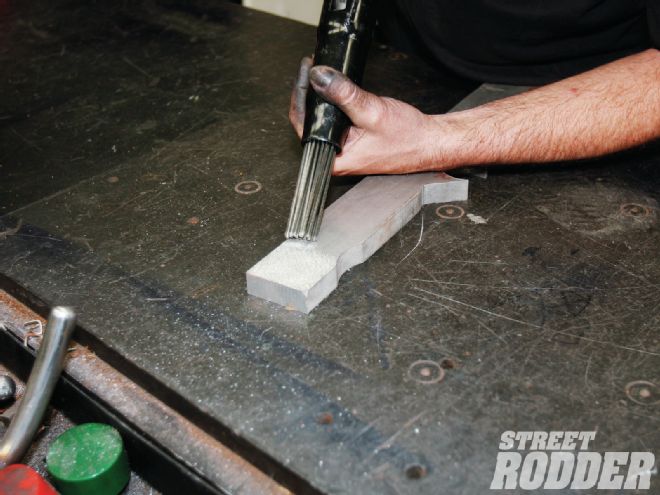 10. HHR used it to add a pebble texture to the Fast Burn heads, giving the aluminum the appearance of cast iron.
10. HHR used it to add a pebble texture to the Fast Burn heads, giving the aluminum the appearance of cast iron.
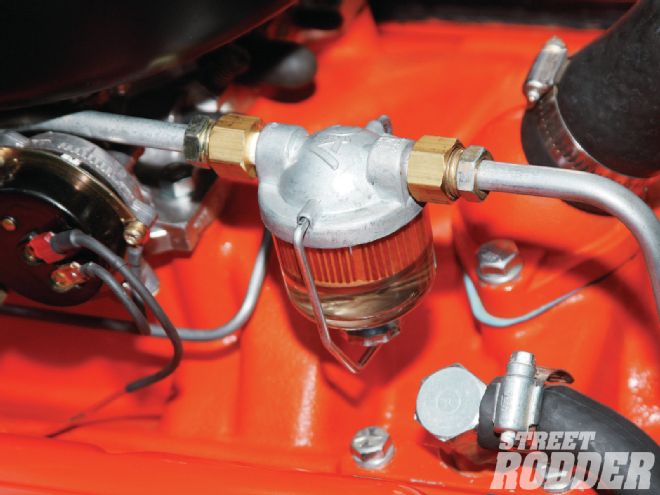 11. The glass-bowl fuel filter is another aftermarket reproduction piece, and features the A/C logo on the dome top.
11. The glass-bowl fuel filter is another aftermarket reproduction piece, and features the A/C logo on the dome top.
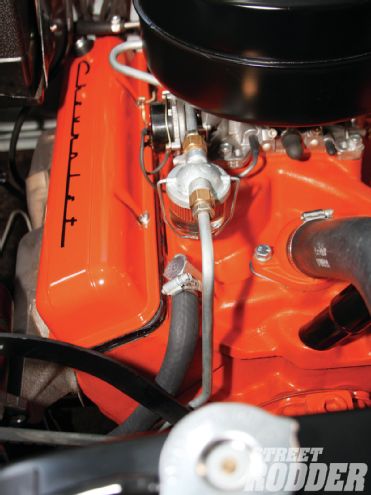 12. The heater hose is located in the back on a 265, but was kept in the front location here. Look closely at the back of the valve cover to see where HHR discreetly hid a PCV valve and baffle.
12. The heater hose is located in the back on a 265, but was kept in the front location here. Look closely at the back of the valve cover to see where HHR discreetly hid a PCV valve and baffle.
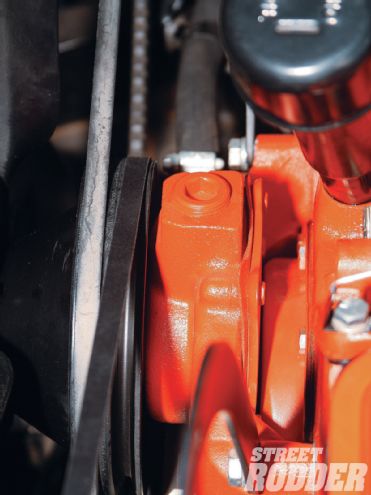 13. The short water pump is a period-appropriate choice.
13. The short water pump is a period-appropriate choice.
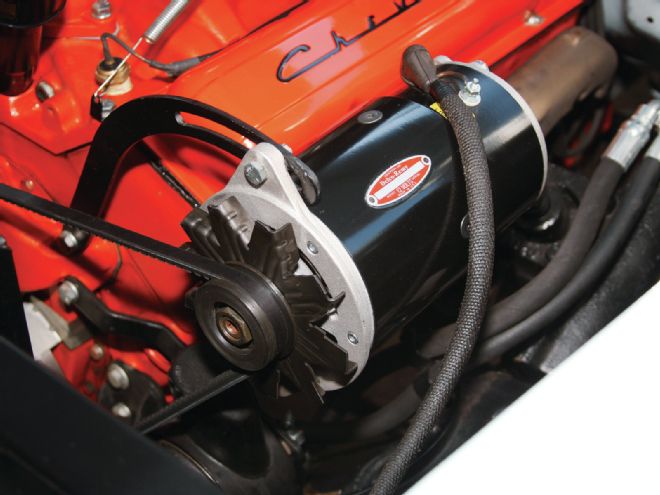 14. The PowerGen 12V alternator housed in a generator case is from Powermaster (powermasterperformance.co). HHR chose the black finish version and added an original Delco-Remy tag. This version also features the indicator light option, keeping the stock generator light in the dash functional. Similarly, the factory oil light is kept functional by an oil pressure on/off gauge on the back of the engine.
14. The PowerGen 12V alternator housed in a generator case is from Powermaster (powermasterperformance.co). HHR chose the black finish version and added an original Delco-Remy tag. This version also features the indicator light option, keeping the stock generator light in the dash functional. Similarly, the factory oil light is kept functional by an oil pressure on/off gauge on the back of the engine.
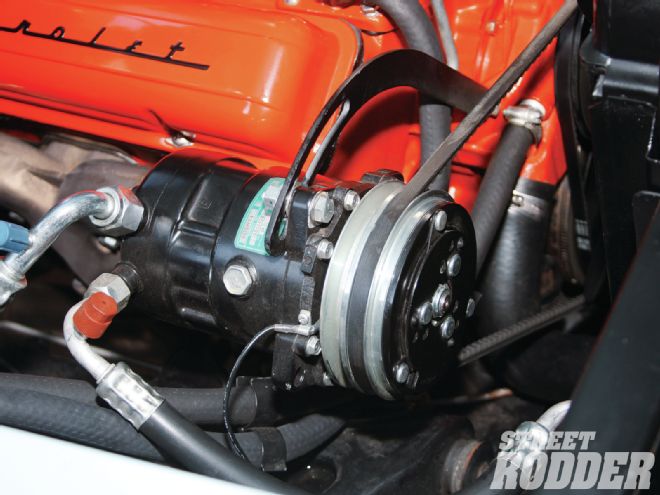 15. With no efficient way to hide the Sanden SD5 series A/C compressor, the next best approach was to minimize its presence. It was painted black, mounted symmetrically to the PowerGen, and plumbed with rubber hoses.
15. With no efficient way to hide the Sanden SD5 series A/C compressor, the next best approach was to minimize its presence. It was painted black, mounted symmetrically to the PowerGen, and plumbed with rubber hoses.
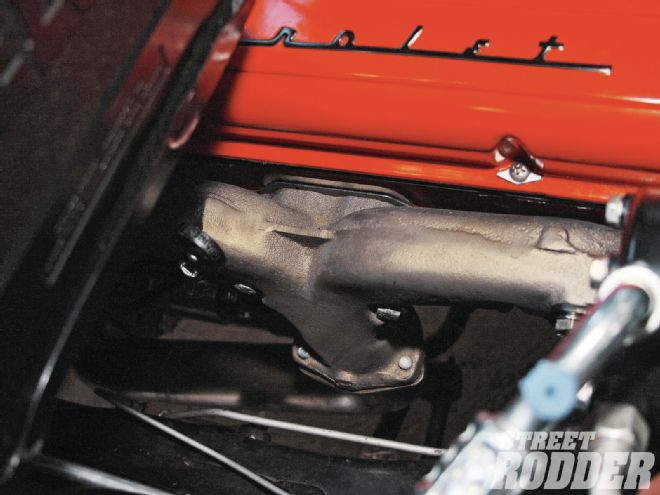 16. These ram’s horn 2-1/2-inch manifolds, readily available for ’64-65 Corvette applications, are not exactly correct for 1955 but the stock 265 manifolds are far too restrictive for the ZZ383. These reproductions have the same bolt pattern as the Fast Burn heads, but the port shapes are different. Ladd ported each one by hand to make them match.
16. These ram’s horn 2-1/2-inch manifolds, readily available for ’64-65 Corvette applications, are not exactly correct for 1955 but the stock 265 manifolds are far too restrictive for the ZZ383. These reproductions have the same bolt pattern as the Fast Burn heads, but the port shapes are different. Ladd ported each one by hand to make them match.
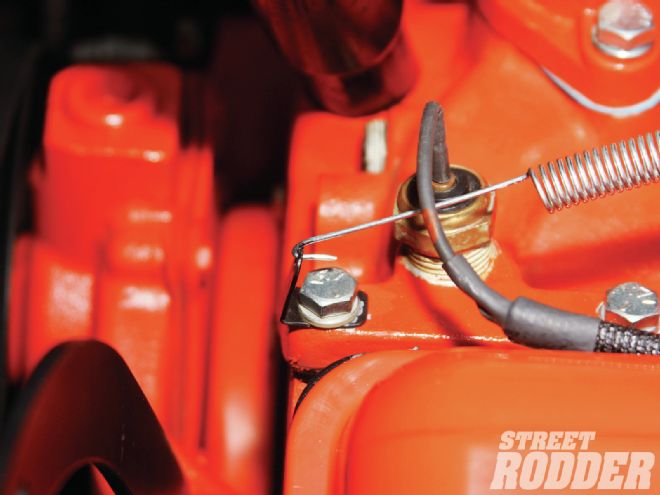 17. The sender for the factory temperature gauge was adapted to the temp gauge in the stock ’55 dash.
17. The sender for the factory temperature gauge was adapted to the temp gauge in the stock ’55 dash.
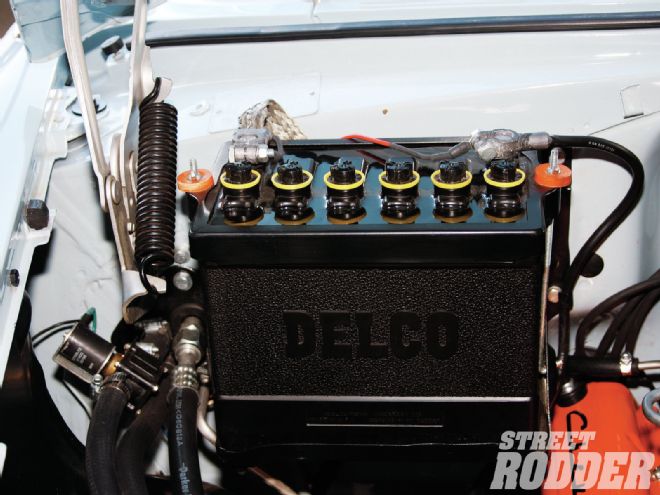 18. The battery is an aftermarket replica of an original 1955 Chevy Delco tar top battery, but with a modern no-maintenance gel cell sealed inside. These well-detailed reproductions are available from several sources, including Year One (yearone.com, PN TR642) and Classic Industries (classicindustries.com, PN BY12003).
18. The battery is an aftermarket replica of an original 1955 Chevy Delco tar top battery, but with a modern no-maintenance gel cell sealed inside. These well-detailed reproductions are available from several sources, including Year One (yearone.com, PN TR642) and Classic Industries (classicindustries.com, PN BY12003).
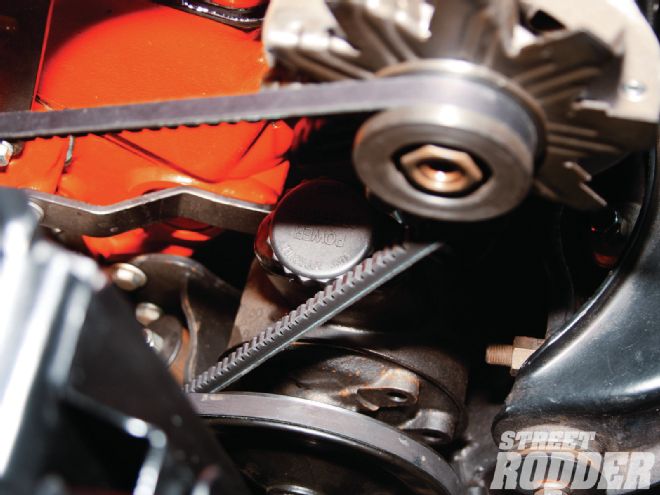 19. The plan was to mount the power steering pump behind the generator housing as done originally, but it was impractical, so it was mounted low below the alternator. The pump and bracket were part of a kit that included the front motor mount bracket, partially visible to the left. The original steering column was modified to work with a (not period-correct) 605 steering box.
19. The plan was to mount the power steering pump behind the generator housing as done originally, but it was impractical, so it was mounted low below the alternator. The pump and bracket were part of a kit that included the front motor mount bracket, partially visible to the left. The original steering column was modified to work with a (not period-correct) 605 steering box.
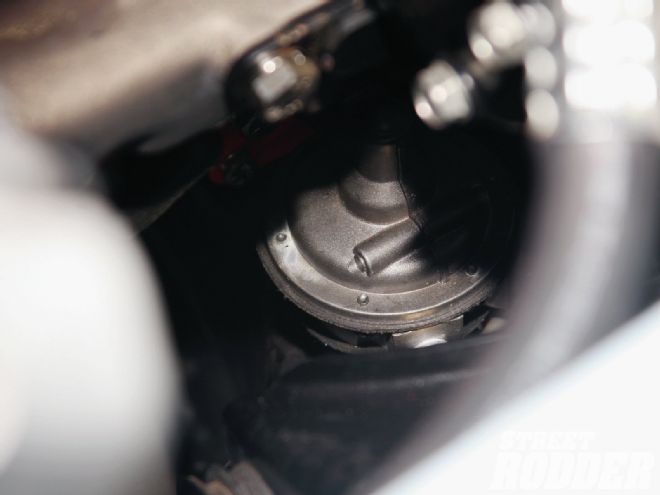 20. The cast mechanical fuel pump was ordered from Summit Racing (summitracing.com) and looks very similar to a stock 265 pump.
20. The cast mechanical fuel pump was ordered from Summit Racing (summitracing.com) and looks very similar to a stock 265 pump.
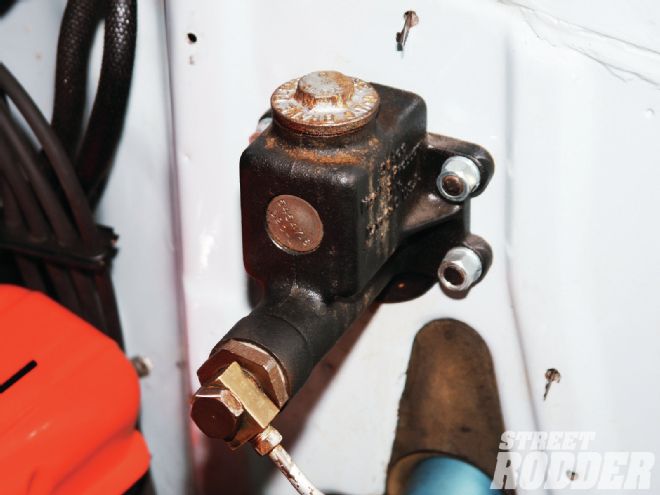 21. HHR modified the 1955 Chevy single-reservoir master cylinder (soon to be painted) for the upgraded brakes. The stock internal check valve was removed and an inline 10-pound valve for the rear drums and a proportioning valve for the 10-inch front discs was added. The ratio is right and the brakes work well, but this setup was chosen strictly for keeping the stock appearance; a dual-reservoir master cylinder is highly recommended for safety.
21. HHR modified the 1955 Chevy single-reservoir master cylinder (soon to be painted) for the upgraded brakes. The stock internal check valve was removed and an inline 10-pound valve for the rear drums and a proportioning valve for the 10-inch front discs was added. The ratio is right and the brakes work well, but this setup was chosen strictly for keeping the stock appearance; a dual-reservoir master cylinder is highly recommended for safety.
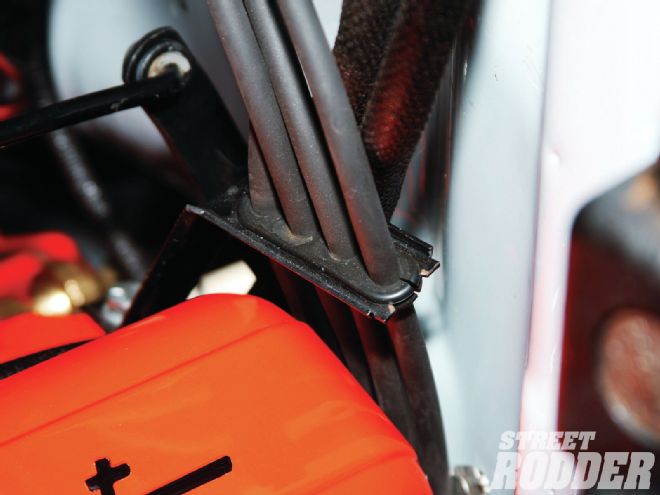 22. Black plug wires and a reproduction loom are accurate for the 1955. It’s a low-key detail, but overlooking some of these areas can spoil the whole effect.
22. Black plug wires and a reproduction loom are accurate for the 1955. It’s a low-key detail, but overlooking some of these areas can spoil the whole effect.
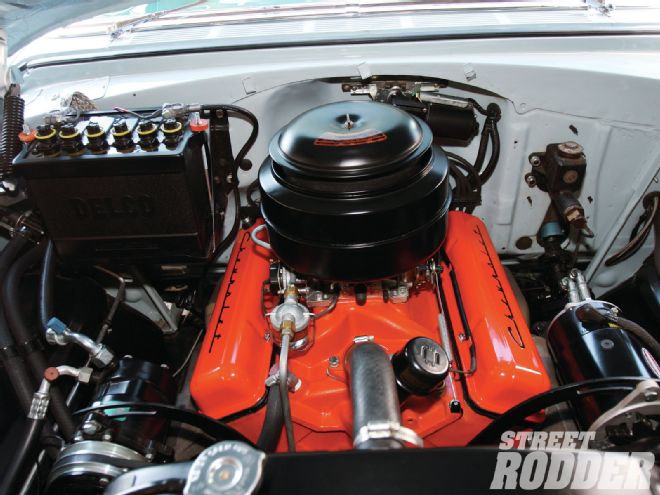 23. What do you see—a ZZ383 or a 265?
23. What do you see—a ZZ383 or a 265?